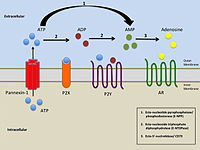P2Y receptor
| Part of a series on |
| Purinergic signalling |
|---|
 |
| Concepts |
| Membrane transporters |
|
P2Y receptors are a family of
P2Y receptors are present in almost all
Structure

P2Y receptors are
In addition to the structural domains typical of all GPCRs, some structural elements are common across P2Y receptor subtypes. All P2Y receptors contain four extracellular
The ligand-binding mechanisms of P2Y receptors are not currently well established.[8] The binding complex of P2Y receptors with ATP is of significant interest, as no P2Y receptor contains amino acids sequences similar to any of the many established ATP-binding sites.[7] Recent x-ray crystallography of the human P2Y12 receptor has shown several structural irregularities in regions that are typically highly conserved across GPCRs.[8]
In contrast to the unusual structure and behavior of the extracellular ligand binding domains, P2Y intracellular domains appear to be structurally and mechanistically similar to other GPCRs.[6]
Signal transduction
P2Y receptors respond either positively or negatively to the presence of nucleotides in extracellular solution.[9] Nucleotides may be divided into two categories: purines and pyrimidines. Individual P2Y receptor species may respond to only purines, only pyrimidines, or both; the activation profiles of the eight known P2Y receptors are listed below.[9]
| P2Y species | Receptivity |
|---|---|
| P2Y1 | Activation by purines[9] |
| P2Y2 | Activation by purines and pyrimidines triphosphates[9] |
| P2Y4 | Activation by pyrimidines[9] |
| P2Y6 | Activation by pyrimidines[9] |
| P2Y11 | Activation by purines[9] |
| P2Y12 | Inactivation by ADP through G1 protein[9] |
| P2Y13 | Inactivation by ADP through G1 protein[9] |
| P2Y14 | Activation by UDP-Glucose[9] |
The activity of P2Y receptors is linked to a signal cascade originating in regulation of the flow of Ca2+ and K+ ions by the receptor's interactions with G proteins, modulating access to Ca2+ and K+ channels, though the exact behavior is dependent upon individual receptor species.[10] Voltage-independent Ca2+ channels allow for the free flow of Ca2+ ions from the cell activated by P2Y receptors.[10] Oscillation of Ca2+ concentration is directly affected by the signal-transduction activity of P2Y1; specifically, through protein kinase C phosphorylation of Thr339 in the carboxy terminus of the P2Y1 receptor.[10]
Changes in the concentration of Ca2+ have many important ramifications for the cell, including regulation of cell metabolism (e.g. autophagy initiation / regulation), ATP production (through Ca2+ entering the mitochondrial outer mitochondrial membrane and stimulation of mitochondrial dehydrogenases leading to the production of ATP), and the possibility of triggering apoptosis.[11][12] Both autophagy and apoptosis are cell stress responses that play significant roles in cells' overall life cycles, though autophagy seeks to preserve the viability of the cell by recycling unit parts of organelles, while apoptosis acts in the interest of the whole organism at the expense of the cell undergoing apoptosis.[12]
Pharmacology

Many commonly prescribed medications target P2Y receptors, and active research is being conducted into developing new drugs targeting these receptors.[3] The most commonly prescribed drug targeting P2Y receptors is clopidogrel, an antiplatelet medication which acts on the P2Y12 receptor in a manner shared with other thienopyridines.[14] Other pharmaceutical applications include denufosol, which targets P2Y2 and is being investigated for the treatment of cystic fibrosis, and diquafosol, a P2Y2 agonist used in the treatment of dry eye disease.[15][16][17]
P2Y6 receptors have been shown to play a role in cerebral vasodilation. UDP-analogs which bind to this receptor have been investigated as possible treatments for migraines.[18][17]
P2Y11 is a regulator of immune response, and a common polymorphism carried by almost 20% of North European caucasians give increased risk of myocardial infarction, making P2Y11 an interesting drug target candidate for treatment of myocardial infarction.[4][16][17]
In addition to established uses, pharmaceutical research has been conducted into the role of P2Y receptors in
Coupling
The biological effects of P2Y receptor activation depends on how they couple to downstream signalling pathways, either via
| Protein | Gene | Coupling | Nucleotide |
| P2RY1 | P2RY1 | Gq/11 | ADP |
| P2RY2 | P2RY2 | Gq/11 (and Gi) | ATP, UTP |
| P2RY4 | P2RY4 | Gq/11 (and Gi) | UTP |
| P2RY5 / LPA6 | LPAR6 | Lysophosphatidic acid[22] | |
| P2RY6 | P2RY6 | Gq/11 | UDP |
| P2RY8 | P2RY8 | orphan receptor | |
| P2RY9 / LPAR4 / GPR23 | LPAR4 | Lysophosphatidic acid | |
| P2RY10 | P2RY10 | orphan receptor | |
| P2RY11 | P2RY11 | Gq/11 and Gs | ATP |
P2RY12 |
P2RY12 | Gi | ADP |
| P2RY13 | P2RY13 | Gi | ADP |
| P2RY14 | P2RY14 | Gi | UDP-glucose
|
The gaps in P2Y receptor numbering is due to that several receptors (P2Y3, P2Y5, P2Y7, P2Y8, P2Y9, P2Y10) were thought to be P2Y receptors when they were cloned, when in fact they are not.
See also
References
- PMID 16968944.
- ^ PMID 16697713.
- ^ PMID 21586366.
- ^ PMID 17135283.
- PMID 23336097.
- ^ ISBN 978-0-12-385526-8. Retrieved 8 November 2018.
- ^ ISBN 978-0-12-378631-9.
- ^ PMID 24670650.
- ^ PMID 15924261.
- ^ PMID 18404483.
- PMID 17074387.
- ^ PMID 21571367.
- PMID 23839745.
- PMID 28921447.
- PMID 18560615.
- ^ PMID 26908460.
- ^ PMID 26519900.
- PMID 12737633.
- PMID 20526761.
- PMID 16939682.
- ^ HUGO Gene Nomenclature Committee, Gene Family: Purinergic receptors P2Y (P2RY), retrieved 2017-01-26.
- PMID 18297070.
External links
- Ivar von Kügelgen: Pharmacology of mammalian P2X- and P2Y-receptors, BIOTREND Reviews No. 03, September 2008,© 2008 BIOTREND Chemicals AG
- "P2Y Receptors". IUPHAR Database of Receptors and Ion Channels. International Union of Basic and Clinical Pharmacology.
- Purinergic+P2+receptors at the U.S. National Library of Medicine Medical Subject Headings (MeSH)
